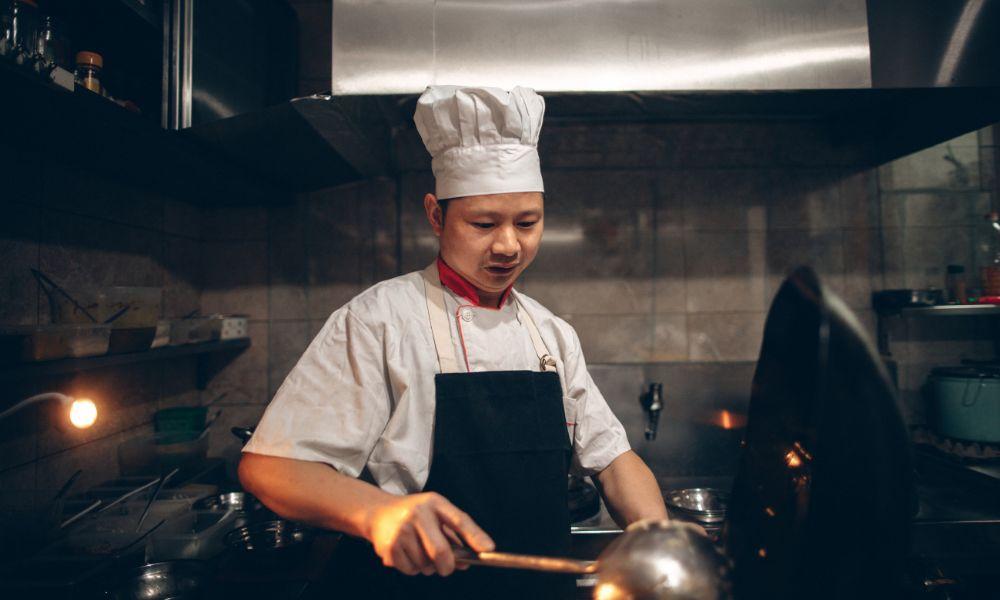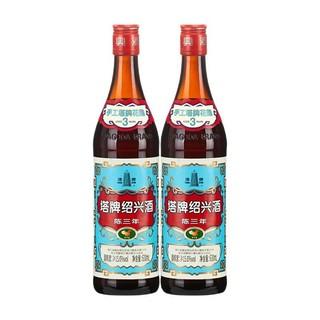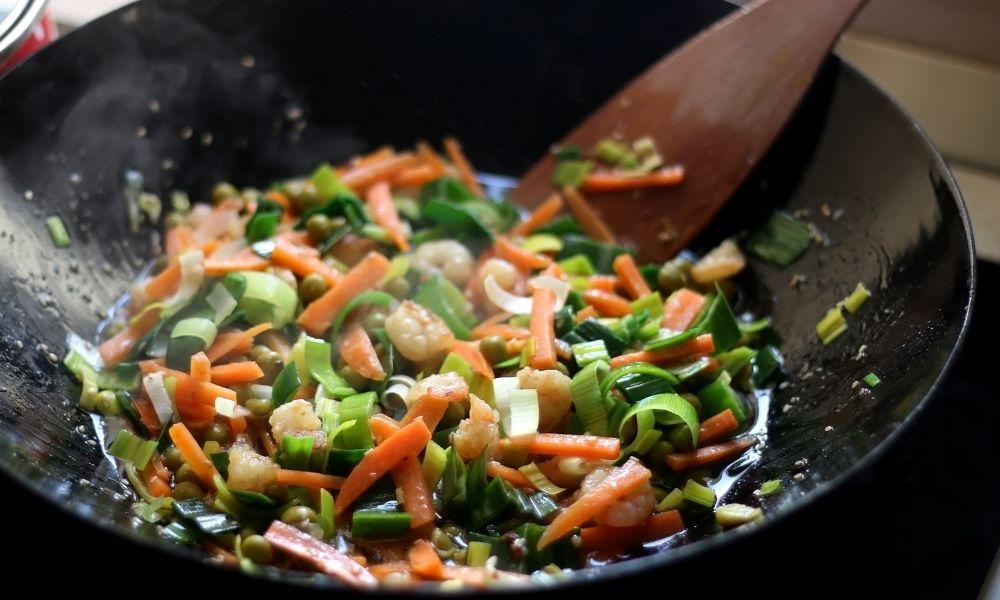Shaoxing wine, also known as Chinese rice wine, is a staple ingredient in numerous Chinese dishes. Originating from the Shaoxing region in China, it infuses your cuisine with a unique depth of flavor and enhances sauces to perfection. But what if you don’t have it on hand, need a non-alcoholic substitute, or just can’t find it in your local stores?
Not to worry. This guide is dedicated to providing you with the best substitutes for Shaoxing wine, ready to take your culinary creations to new heights. Let’s explore these alternatives, understanding their flavor profiles, and how to use each of them effectively for authentic results in your kitchen.

Brief history of Shaoxing wine
Shaoxing wine has a rich history dating back to over 2,500 years ago, during the Spring and Autumn Period in China. The wine is made from fermenting glutinous rice, wheat, and water. The unique taste and aroma of Shaoxing wine are due to its distinct production process, which includes aging the wine in earthenware pots for several years. It’s said that the longer the wine is aged, the better its taste and quality.
Throughout history, Shaoxing wine has been praised for its medicinal properties and has been an essential ingredient in traditional Chinese medicine. The wine is also closely associated with Chinese culture, often used in ceremonies, rituals, and celebrations.
Importance of Shaoxing wine in Chinese cooking

Shaoxing wine holds a prominent place in Chinese cuisine, particularly in dishes from the Zhejiang province, where the city of Shaoxing is located. The wine adds a unique depth of flavor to dishes, giving them a rich, aromatic taste that is difficult to replicate with other ingredients.
In Chinese cooking, Shaoxing wine is often used to marinate meats, enhance the flavors of soups and sauces, and deglaze pans. It is a crucial ingredient in many popular Chinese dishes, such as drunken chicken, red-cooked pork, and Cantonese clay pot rice.
The importance of Shaoxing wine in Chinese cooking goes beyond its flavor contribution; it is also believed to help tenderize meats, remove strong odors, and counterbalance greasiness in dishes. Given its significance, finding a suitable alternative to Shaoxing wine is crucial for maintaining the authenticity and taste of Chinese dishes.
Common ingredients found in Shaoxing wine

The production process and ingredients used in making Shaoxing wine contribute to its distinct characteristics. Here are the common ingredients found in Shaoxing wine:
Glutinous rice
Also known as sticky rice, glutinous rice is the primary ingredient in Shaoxing wine. It is high in starch, which contributes to the wine’s viscosity and sweetness. The rice is soaked, steamed, and then spread out to cool before being mixed with other ingredients.
Wheat
Wheat is used as a fermentation agent in the production of Shaoxing wine. It is ground into a powder and mixed with the glutinous rice to help break down the starches and convert them into sugars during the fermentation process.
Water
High-quality water is essential for making Shaoxing wine, as it affects the final taste and quality of the product. The water used in the production of Shaoxing wine is typically sourced from local wells or springs in the Shaoxing region, ensuring a consistent flavor profile.
Yeast culture
A specific yeast culture, known as “Jiuqu” or “wine starter,” is used to initiate the fermentation process. This yeast culture contains various strains of yeast and molds that break down the rice starches into sugars and then convert those sugars into alcohol. The Jiuqu is typically made from a mixture of wheat flour, water, and naturally occurring yeast and mold spores.
Additives (optional)
Some Shaoxing wines may contain additional ingredients to enhance their flavor, color, or aroma. These additives can include caramel, sugar, or other flavorings. However, high-quality, traditional Shaoxing wines usually do not contain any additives.
The combination of these ingredients, along with the unique production and aging process, gives Shaoxing wine its distinctive taste and aroma, making it a prized ingredient in Chinese cuisine.
Popular Shaoxing Wine Alternatives
While Shaoxing wine is an essential ingredient in many Chinese dishes, there may be instances where it is unavailable or when you need a non-alcoholic alternative. Here, we’ll discuss a popular alternative to Shaoxing wine and provide a flavor profile comparison and guidance on how to use it in recipes.
| Alternative | Flavor Profile | Best For |
|---|---|---|
| Dry Sherry | Nutty, slightly sweet, and mildly earthy | Stir-fries, braising, sauces, marinades |
| Mirin | Sweet, slightly tangy, and mild | Marinades, sauces, glazes, stir-fries |
| Sake | Mild, slightly sweet, and fruity | Marinades, sauces, glazes, braising |
| Rice Vinegar | Tangy, mildly sweet, and acidic | Stir-fries, sauces, pickling, dressings |
01 Dry Sherry: My Go-To Substitute for Shaoxing Wine
Trust me when I say, there’s always a bottle of dry sherry in my kitchen. Not just for sipping alongside a platter of tapas but for cooking too! Dry sherry is my secret weapon, my preferred substitute for Shaoxing wine.
Introducing Dry Sherry
Hailing from the sunny vineyards of Spain, dry sherry is versatile like no other – excellent as a beverage and phenomenal in cooking. In my stovetop experiments, Fino and Amontillado sherries have proved to be the best choices for replacing Shaoxing wine.
Why Dry Sherry? The Flavor Comparison
A question I get often is – why dry sherry? Well, both dry sherry and Shaoxing wine carry a nutty, slightly sweet undercurrent which enhances the depth of your dishes wonderfully. Yet, there are a few variations I have noticed over time. While Shaoxing wine envelops your taste buds with its earthy, savory character, dry sherry offers a lighter, brighter taste, with gentle hints of fruitiness and a touch of acidity.
How To Use Dry Sherry in Recipes
Bringing this substitute to life in your kitchen is simple! When replacing Shaoxing wine with dry sherry in a recipe, I stick to a 1:1 ratio. For instance, if a recipe calls for 1/4 cup of Shaoxing wine, use 1/4 cup of dry sherry instead. Here are a couple of tips from my kitchen to yours:
Go for dry sherry varieties like Fino or Amontillado for a closer match to Shaoxing wine.
Some sherries can be a touch sweeter than Shaoxing wine. So if your dish tastes a bit sweet, adjust your sugar or other sweet ingredients accordingly.
The Journey is Just as Important as the Destination!
As you navigate the exciting world of cooking with these substitutes, remember to savor each moment. From the first pour of sherry to the final tasty dish, cooking is indeed an adventure. Enjoy the process, and don’t forget to share your culinary stories with us! We always love to hear about your experiments in the kitchen.
02 Mirin – Delve into the Sweet Surprise of a Perfect Substitute
Have you ever tried Mirin? It’s this delightful Japanese cooking wine that I’ve found to be a wonderful substitute for Shaoxing wine. Is it an exact match, you ask? Not exactly. But in the art of cooking, it’s all about creativity and invention, and mirin brings its own delicious charm.
The Flavor Stand-off – Mirin vs Shaoxing Wine
Comparing Mirin and Shaoxing wine is like comparing two exquisite, yet very different, works of art. Mirin is sweet and gentle, with a subtle hint of alcohol – a quiet whisper of Japanese cherry blossoms if you will.
On the opposite canvas, we have Shaoxing wine that beckons with an earthy and savory intensity, akin to an invigorating autumnal feast. Yes, the flavors differ, but here’s the beauty of it – variability is the spice of life, and indeed, cooking.
Recipes are Your Canvas, Let’s Paint!
So you’ve decided to journey down the mirin route instead of Shaoxing wine, here’s my two cents on how to navigate:
Take It Slow With Quantity – As mirin paints with a sweeter brush, you might need to set your own pace. Start with about 3/4 the amount you’d usually use with Shaoxing wine. Be not afraid – your tastebuds make the ultimate judgement. Adjust to your liking, and remember, you can always add more if you need to.
Balancing The Sweet Act – If your chosen recipe calls for an additional sprinkle of sugar, perhaps scale it back a notch to make way for mirin’s natural sweetness. Your dish will thank you for this thoughtful balance.
Enter the Soy Sauce – At times, I’ve found that the humble soy sauce lends a helping hand to maintain the flavor fulcrum when using mirin, even doing a pretty impressive Shaoxing wine evening act, if I do say so myself.
Watch the Time, Craft the Flavor – An interesting attribute about mirin is its lower alcohol content, meaning it likes to stay a bit longer on the stovetop. This might mean, just a little extra vigilance to ensure all the flavors are playing nicely together.
03 Sake: A Japanese Delicacy for Your Culinary Adventure
Everyone who loves experimenting with various world cuisines in their kitchen, like me, has probably crossed paths with sake. This delightful Japanese rice wine, albeit a lighter substitute, can hold its own when replacing Shaoxing wine.
Sake vs Shaoxing Wine: A Flavor Comparison
Jumping right into the waves of flavor, you’ll notice that Sake charms you with its lighter, more delicate flair compared to the rich, earthy character of Shaoxing wine. The latter, Shaoxing wine, is often described as slightly sweeter and richer, whereas Sake feels cleaner and crisper to the palate.
Still, with some careful crafting, sake can prove to be an enchanting substitute for Shaoxing wine.
Sake in Recipes: Conquering New Culinary Horizons
Embarking on this new flavor journey is simple. Let me share some of my tried and trusted tips:
The rule of equality: Stick to a 1:1 ratio when replacing Shaoxing wine with sake. The flavors will differ, so remember, all the power rests in your hands (and taste buds) to tweak and adjust as you desire.
The flavor enhancers: Since Sake is milder, a pinch of sugar or a dash of soy sauce could bring you closer to the taste of Shaoxing wine. Begin with modest amounts and add more as per your preference.
Picking your Sake: Much like in life, not all sakes are created equal. Avoid the high-end, refined ones for cooking as their intricate flavors tend to disappear during the cooking process. Your best bet? Go for a mid-range sake. Trust me, your dishes will thank you.
Watch the Clock: Cooking with Sake instead of Shaoxing wine might subtly alter the cooking time due to varying alcohol contents and flavor profiles. Keep a vigilant eye on your culinary masterpiece and adjust the cooking time as necessary.
And there you have it! Experimenting with sake as a substitute for Shaoxing wine may bring some new twists in your dishes. So go ahead, embrace this culinary adventure with Sake – who knows what delightful new flavors await you!
04 Rice Vinegar: A Tangy Twist to Your Recipes
Here’s another exquisite detour on the culinary map – rice vinegar. Though a non-alcoholic alternative, it can bring an interesting zing to dishes that typically call for Shaoxing wine.
A Flavor Face-off: Rice Vinegar vs. Shaoxing Wine
When it comes to flavor comparisons, rice vinegar and Shaoxing wine are like characters from different novels. Rice vinegar walks on the tangy, acidic side of the taste street, while Shaoxing wine sways with sweeter, earthy, nutty tunes. Even though they dance to different rhythms, both can add a unique depth to your dishes.
Recipe Revisions with Rice Vinegar
So how do we waltz with rice vinegar in replacer’s shoes for Shaoxing wine? Here’s my personal recipe-dancing code:
Start Small, Taste Big: Given its unique tanginess, you might want to use less rice vinegar than you would Shaoxing wine. My advice? Start with half the amount and let your taste buds guide you.
Sweetness Check: To counterbalance the acidity, consider adding a pinch of sugar or a few drops of water. Trust me, these little touches can harmonize the rice vinegar’s sharpness while maintaining a robust flavor profile.
Pick and Choose: There’s absolutely no one-size-fits-all in cooking. Hence, opt for a milder rice vinegar, like white or Chinese rice vinegar. They can steal the Shaoxing wine’s thunder quite effortlessly. I’d suggest staying away from the red or black rice vinegar, as their bold flavors might overshadow the other ingredients.
The Mix and Match Dance: Sometimes, blending rice vinegar with other elements like Mirin or sake results in a delightful medley that mimics the Shaoxing wine closely. Try it out, and you might unveil a brand-new flavor secret.
Lesser-Known Substitutes
While there are several popular alternatives to Shaoxing wine, some lesser-known substitutes can still provide great results in your recipes. One such substitute is Chinese black vinegar, also known as Chinkiang vinegar or Zhenjiang vinegar.
| Alternative | Flavor Profile | Best For |
|---|---|---|
| Chinese Black Vinegar | Tangy, mildly sweet, and slightly smoky | Stir-fries, sauces, dipping sauces |
| Chinese White Vinegar | Sharp, clean, and acidic | Stir-fries, sauces, marinades, pickling |
| Chinese Rose Wine | Fragrant, floral, and slightly sweet | Braising, sauces, marinades, glazes |
Chinese Black Vinegar
Made from fermented black rice or glutinous rice, Chinese black vinegar is a versatile ingredient that can add depth to your dishes. While it’s not an exact match for Shaoxing wine, it can still work well in certain recipes when used appropriately.
Flavor profile comparison
When comparing the flavor profiles of Chinese black vinegar and Shaoxing wine, there are some key differences:
- Chinese black vinegar has a tangy, mildly sweet, and slightly smoky taste, while Shaoxing wine is characterized by its earthy, nutty, and sweet flavor.
- Chinese black vinegar is more acidic than Shaoxing wine, which has a higher alcohol content and a richer flavor.
Despite these differences, Chinese black vinegar can still be used as a substitute for Shaoxing wine in recipes that can benefit from its tangy and smoky notes.
How to use in recipes
To use Chinese black vinegar as a substitute for Shaoxing wine, consider the following tips:
- Adjust the amount: Since Chinese black vinegar is more acidic and has a stronger flavor than Shaoxing wine, you may need to use a smaller amount to avoid overpowering the dish. Start with half the amount of black vinegar as you would Shaoxing wine and adjust according to taste.
- Combine with other ingredients: To better mimic the taste of Shaoxing wine, consider combining Chinese black vinegar with other ingredients, such as sugar, soy sauce, or even a splash of another mild rice wine like sake or mirin.
- Choose the right recipe: Chinese black vinegar works best as a substitute for Shaoxing wine in recipes where its tangy and smoky notes can complement the dish. It might not be suitable for all recipes that call for Shaoxing wine, especially those requiring a milder, sweeter taste.
Chinese White Vinegar
Chinese white vinegar, made from fermented rice or sorghum, is another alternative to Shaoxing wine that can be used in certain recipes. While it has a different flavor profile than Shaoxing wine, it can still provide a tangy element to your dishes.
Flavor profile comparison
Comparing the flavor profiles of Chinese white vinegar and Shaoxing wine, there are several notable differences:
- Chinese white vinegar has a clean, sharp, and acidic taste, while Shaoxing wine is characterized by a sweeter, earthy, and slightly nutty flavor.
- Shaoxing wine has a higher alcohol content, whereas Chinese white vinegar is non-alcoholic.
Despite these differences, Chinese white vinegar can still be used as a substitute for Shaoxing wine in recipes where a tangy, acidic element is desired.
How to use in recipes
To use Chinese white vinegar as a substitute for Shaoxing wine, follow these guidelines:
- Adjust the amount: Since Chinese white vinegar has a more acidic taste, you may need to use a smaller amount to prevent overpowering the dish. Start by using half the amount of white vinegar as you would Shaoxing wine and adjust to taste.
- Add sugar or water: To balance the acidity of Chinese white vinegar, consider adding a small amount of sugar or water to the recipe. This can help mimic the sweetness and mildness of Shaoxing wine.
- Choose the right recipe: Chinese white vinegar works best as a substitute for Shaoxing wine in recipes where its tangy and acidic notes can complement the dish. It might not be suitable for all recipes that call for Shaoxing wine, especially those requiring a milder, sweeter taste.
Chinese rose wine

Chinese rose wine, also known as Mei Kuei Lu Chiew or rose essence wine, is a unique alternative to Shaoxing wine that can be used in certain recipes. Made from distilled sorghum infused with rose petals, it has a distinctive flavor that adds a floral touch to your dishes.
Flavor profile comparison
Comparing the flavor profiles of Chinese rose wine and Shaoxing wine, there are several notable differences:
- Chinese rose wine has a fragrant, floral, and slightly sweet taste, while Shaoxing wine is characterized by a sweeter, earthy, and slightly nutty flavor.
- Shaoxing wine has a higher alcohol content and a richer flavor, whereas Chinese rose wine is milder and more aromatic.
Despite these differences, Chinese rose wine can still be used as a substitute for Shaoxing wine in recipes where a floral element is desired.
How to use in recipes
To use Chinese rose wine as a substitute for Shaoxing wine, follow these guidelines:
- Use a 1:1 ratio: You can generally replace Shaoxing wine with an equal amount of Chinese rose wine in recipes. However, you might need to adjust the other ingredients to account for the differences in flavor.
- Choose the right recipe: Chinese rose wine works best as a substitute for Shaoxing wine in recipes where its fragrant, floral notes can complement the dish. It might not be suitable for all recipes that call for Shaoxing wine, especially those requiring a more robust, earthy taste.
- Consider combining with other ingredients: In some recipes, you may want to combine Chinese rose wine with other ingredients, such as a splash of another mild rice wine like sake or mirin, to achieve a more well-rounded flavor profile that better resembles Shaoxing wine.
Creating Your Own Shaoxing Wine Alternative
If you can’t find a suitable Shaoxing wine substitute or want to create a more personalized flavor, consider making your own Shaoxing wine alternative. By combining various ingredients and adjusting the sweetness and acidity levels, you can create a customized flavor that complements your dishes.
Combining ingredients for a customized flavor
To create your own Shaoxing wine alternative, start by selecting a base ingredient, such as:
- Dry sherry
- Sake
- Mirin
- Rice vinegar
- Chinese white vinegar
Next, consider adding other ingredients to achieve a more complex flavor profile, such as:
- Soy sauce: To add some umami and depth to your alternative.
- Sugar or honey: To increase sweetness and balance acidity.
- A splash of another wine or vinegar: To add complexity and adjust the overall flavor.
Adjusting the sweetness and acidity levels
When creating your own Shaoxing wine alternative, you may need to adjust the sweetness and acidity levels to better match the taste of Shaoxing wine. You can do this by:
- Adding sugar or honey to increase sweetness.
- Diluting with water or a milder wine or vinegar to reduce acidity.
- Balancing the sweetness and acidity by adding a small amount of an opposing ingredient (for example, add a splash of vinegar to increase acidity or a pinch of sugar to reduce acidity).
Tips for achieving the desired taste
To create a successful Shaoxing wine alternative, consider these tips:
- Taste as you go: As you mix and adjust your alternative, taste it regularly to ensure you’re achieving the desired flavor.
- Experiment with ratios: Start with a smaller amount of each ingredient, and adjust the ratios as needed to achieve a balanced taste.
- Take notes: Keep track of the ingredients and ratios you use, so you can replicate your successful Shaoxing wine alternative in future recipes.
- Be flexible: Depending on the specific recipe you’re using, you may need to adjust your Shaoxing wine alternative to better suit the dish.
Pairing Shaoxing Wine Alternatives with Dishes

Finding the right Shaoxing wine alternative for a specific dish requires understanding how the flavors complement each other and being open to experimenting with different substitutes. Here are some recommendations and tips for pairing Shaoxing wine alternatives with various dishes.
Recommendations for specific dishes
- Stir-fries: Dry sherry or Chinese black vinegar can work well in stir-fry recipes, adding depth of flavor without overpowering the dish. Mirin or sake can also be used for a milder, slightly sweet taste.
- Marinades: For marinating meats, consider using sake or mirin, as their mild flavors will not overpower the meat’s natural taste. Rice vinegar or Chinese white vinegar can also be used to add tanginess, but be sure to adjust the amount and balance the acidity.
- Braising: Chinese rose wine or dry sherry can be good alternatives for braising, as their subtle flavors will enhance the dish without clashing with other ingredients. You can also try combining different alternatives, such as mirin and sake, to create a more complex flavor profile.
- Sauces: In sauces, try using Chinese black vinegar or rice vinegar for a tangy, acidic element. If you prefer a sweeter sauce, opt for mirin or sake. Be sure to adjust the sweetness and acidity levels as needed.
Understanding how flavors complement each other
When selecting a Shaoxing wine alternative for a specific dish, consider how the substitute’s flavor profile will interact with the other ingredients. Keep in mind the following principles:
- Sweet flavors can balance out salty, spicy, and sour ingredients.
- Tangy or acidic flavors can cut through richness and add brightness to a dish.
- Earthy, umami flavors can add depth and complexity.
Experimenting with different substitutes
Don’t be afraid to experiment with different Shaoxing wine alternatives, as this will help you discover new flavor combinations and find the best match for your recipes. Keep in mind that the ideal substitute may vary depending on the specific dish and your personal taste preferences.
Conclusion
Embracing the versatility of Shaoxing wine alternatives is an excellent way to expand your culinary repertoire and adapt your recipes to accommodate different tastes and dietary preferences. By understanding the unique flavor profiles of each substitute, you can effectively choose the best option for your dishes, whether it’s for a stir-fry, sauce, marinade, or braising.
Enhancing your culinary skills through experimentation is essential in discovering new flavor combinations and perfecting your recipes. Don’t be afraid to try various Shaoxing wine alternatives and even create your own customized blend to suit your taste buds. By doing so, you’ll not only broaden your knowledge of different ingredients but also elevate your cooking skills, allowing you to create delicious and satisfying meals for yourself and others.
FAQs
Can I simply omit Shaoxing wine from a recipe if I don’t have a substitute?
Yes, you can omit Shaoxing wine from a recipe if you don’t have a substitute. However, keep in mind that Shaoxing wine is an essential ingredient in many Chinese dishes and omitting it may alter the flavor of the dish.
Are there any non-alcoholic alternatives to Shaoxing wine?
Yes, you can use non-alcoholic substitutes such as chicken or vegetable broth, apple cider vinegar, or even water with a pinch of sugar or soy sauce to add flavor to the dish.
How can I adjust the flavor of a dish when using a Shaoxing wine alternative?
You can adjust the flavor of a dish when using a Shaoxing wine alternative by adding additional ingredients such as sugar, soy sauce, or another mild rice wine, or by adjusting the amount of the alternative used to balance the flavor.
Is it safe to use Shaoxing wine in cooking if I have a gluten allergy?
Shaoxing wine is traditionally made from glutinous rice and is generally considered gluten-free. However, it’s always best to check the specific brand or type of Shaoxing wine you’re using to confirm whether it contains gluten.
Can I use Western wines, such as red or white wine, as a substitute for Shaoxing wine?
While Western wines can add depth and complexity to dishes, they are not the best substitute for Shaoxing wine as their flavor profiles are quite different. It’s better to stick to the recommended Shaoxing wine alternatives to achieve a more authentic taste.








